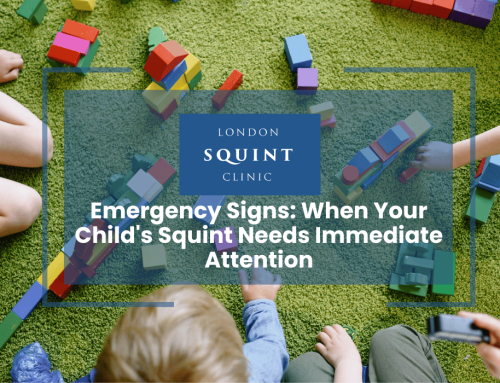Squint in Newborns vs Older Children: Key Differences Parents Need to Know
What Every Parent Should Know About Newborn Eye Alignment
- Occasional eye misalignment is normal in newborns up to 4 months old as their visual system develops.
- Pseudosquint can make a baby’s eyes appear crossed due to facial features, but their eyes are actually aligned.
- Congenital squint, present at birth or developing within 6 months, requires prompt evaluation and treatment to prevent vision problems.
- Concerning signs that warrant a specialist evaluation include constant misalignment after 4 months, frequent squinting, head tilting, and inability to follow objects with both eyes.
- Treatment options for squint may include glasses, patching, eye muscle surgery, and vision therapy, depending on the type and severity of misalignment.
- Regular eye exams and monitoring vision milestones can help identify any issues early and ensure the best possible outcomes for your child’s vision and eye health.
Here is the blog post content with the specified sections and formatting:
Table of Contents
- Understanding Normal Eye Alignment Development in Infants
- Pseudosquint: When a Newborn’s Eyes Appear Misaligned
- Congenital Squint: Types, Causes, and Early Signs
- How Does Infantile Squint Differ from Childhood Strabismus?
- When Should You Be Concerned About Your Baby’s Eye Alignment?
- Effective Treatments for Squint in Newborns and Children
- Monitoring Vision Milestones: What Parents Need to Know
Understanding Normal Eye Alignment Development in Infants
Newborn babies often have eyes that intermittently wander or appear crossed, which is usually normal up until 4 months of age. During the first few months of life, an infant’s visual system is still developing, and the eye muscles are learning to work together to focus and align properly. Occasional misalignment is common as the brain and eyes learn to coordinate.
In most cases, a newborn’s eyes will start to align more consistently by 3-4 months old. If the eyes continue to wander or cross frequently after this age, it may indicate an underlying issue such as strabismus or amblyopia that requires evaluation by a paediatric ophthalmologist. Regular check-ups can help identify any concerning signs early on.
Pseudosquint: When a Newborn’s Eyes Appear Misaligned
Some babies may appear to have crossed eyes due to a condition called pseudosquint. This occurs when the skin fold near the inner corner of the eye is more prominent, creating the illusion of misalignment. Pseudosquint is more noticeable in babies with flat nasal bridges, epicanthal folds, or a wide space between the eyes.
To differentiate between true squint and pseudosquint, observe your baby’s eyes when they are looking at an object directly in front of them. With pseudosquint, the reflection of the light will be in the same spot of each eye, indicating that the eyes are actually aligned. If the light reflection is in different positions, it may signify true misalignment that needs further evaluation.
Congenital Squint: Types, Causes, and Early Signs
Congenital squint, also known as infantile strabismus, is a misalignment of the eyes that is present at birth or develops within the first 6 months of life. The two main types are congenital esotropia, where one or both eyes turn inward, and congenital exotropia, where the eye turns outward. Congenital squint can be constant or intermittent.
The exact causes of congenital squint are not always clear but may include genetic factors, premature birth, cerebral palsy, or other neurological conditions. Early signs to watch for include a consistent inward or outward turning of one or both eyes, inability to focus both eyes on the same object, unusual head tilts, or favouring one eye. Prompt evaluation by a paediatric ophthalmologist is crucial for timely treatment.
How Does Infantile Squint Differ from Childhood Strabismus?
Infantile squint develops within the first 6 months of life, while childhood strabismus can occur at any point during a child’s development. Infantile squint is often associated with more significant refractive errors and a higher risk of amblyopia if not treated promptly. The eye turn may be large and more noticeable in infantile cases.
Childhood strabismus that develops later may be related to uncorrected refractive errors, eye muscle imbalances, or underlying health conditions. Accommodative esotropia, for example, often emerges between 2-3 years old due to uncorrected farsightedness. Childhood squint can also be intermittent or only apparent when a child is tired, ill, or focusing intently. Treatment approaches may vary based on the type and underlying cause of the misalignment.
Regardless of the age of onset, early intervention is key to preventing long-term vision problems and promoting proper binocular vision development. Regular eye exams can help identify any concerning signs and allow for timely management.
When Should You Be Concerned About Your Baby’s Eye Alignment?
While occasional eye misalignment is normal in newborns, there are certain signs that warrant a prompt evaluation by a paediatric ophthalmologist. Consult with a specialist if you notice any of the following:
- Constant eye misalignment after 4 months old
- Frequent squinting or closing one eye
- Tilting or turning the head to look at objects
- Inability to follow objects or faces with both eyes
- Abnormal eye movements or jiggling (nystagmus)
- Family history of childhood eye disorders
Early detection and treatment of eye misalignment are crucial for preventing vision loss and promoting proper visual development. If you have any concerns about your baby’s eye alignment or vision, don’t hesitate to schedule an appointment with a paediatric eye care specialist.
Effective Treatments for Squint in Newborns and Children
Treatment for squint depends on the type, severity, and underlying cause of the misalignment. In some cases, glasses or contact lenses can correct refractive errors and improve alignment. Patching or blurring the stronger eye can help stimulate vision development in the weaker eye and prevent amblyopia.
For more significant misalignments or those not fully corrected with glasses, eye muscle surgery may be recommended. Strabismus surgery involves adjusting the eye muscles to improve alignment and binocular vision. The goal is to achieve straight eyes and allow for the development of depth perception.
Vision therapy exercises, sometimes called orthoptics, can help train the eyes to work together more effectively. This is often used in conjunction with other treatments to enhance binocular vision and maintain long-term alignment. Consistent follow-up with a paediatric ophthalmologist is important to monitor progress and adjust treatment as needed.
Monitoring Vision Milestones: What Parents Need to Know
Tracking your baby’s vision milestones can help you identify any potential issues early on. Here are some key milestones to watch for:
- Newborn to 1 month: Makes eye contact, focuses on faces
- 1-2 months: Follows moving objects, recognizes faces
- 3-4 months: Reaches for objects, eyes align more consistently
- 5-7 months: Develops hand-eye coordination, depth perception
- 8-12 months: Sees clearly at various distances, imitates facial expressions
If you notice your baby is not meeting these milestones or shows signs of vision problems, consult with your paediatrician or a paediatric ophthalmologist. They can perform a comprehensive eye exam to assess your baby’s vision and eye health. Early intervention is key to ensuring the best possible visual outcomes for your child.
Frequently Asked Questions
Is it normal for a newborn’s eyes to cross occasionally?
Yes, it is common for a newborn’s eyes to intermittently wander or appear crossed during the first few months of life. This is usually normal as their visual system is still developing, and the eye muscles are learning to work together. If the misalignment persists beyond 4 months of age, consult with a paediatric ophthalmologist.
How can I tell if my baby has pseudosquint or true squint?
To differentiate between pseudosquint and true squint, observe your baby’s eyes when they are looking directly at an object in front of them. With pseudosquint, the light reflection will be in the same spot on each eye, indicating proper alignment. If the light reflection is in different positions, it may signify true misalignment that requires further evaluation.
What causes congenital squint in babies?
The exact causes of congenital squint are not always clear but may include genetic factors, premature birth, cerebral palsy, or other neurological conditions. Congenital squint can be associated with significant refractive errors and a higher risk of amblyopia if not treated promptly.
When should I be concerned about my baby’s eye alignment?
You should consult with a paediatric ophthalmologist if you notice any of the following signs: constant eye misalignment after 4 months old, frequent squinting or closing one eye, tilting or turning the head to look at objects, inability to follow objects or faces with both eyes, abnormal eye movements or jiggling (nystagmus), or a family history of childhood eye disorders.
What treatments are available for squint in babies and children?
Treatment for squint depends on the type, severity, and underlying cause of the misalignment. Options may include glasses or contact lenses to correct refractive errors, patching or blurring the stronger eye to stimulate vision development in the weaker eye, eye muscle surgery to adjust alignment, and vision therapy exercises to train the eyes to work together more effectively.
How can I monitor my baby’s vision development?
Track your baby’s vision milestones, such as making eye contact and focusing on faces by 1 month, following moving objects by 2 months, reaching for objects and having more consistent eye alignment by 4 months, and developing hand-eye coordination and depth perception by 7 months. If you notice any concerns or delays, consult with your paediatrician or a paediatric ophthalmologist for a comprehensive eye exam.
Find out if you are suitable for Double Vision Treatment
Not everyone is eligible for double vision surgery.
Find out if you could benefit from this life-changing surgery by taking the quick self-suitability quiz below:
Our most popular procedures

Hello, I’m Nadeem Ali
I’m one of the few eye surgeons in the world with 100% focus on Squint and Double Vision Surgery.
I have 24 years of eye surgery experience, and worked for 13 years as a Consultant at London’s renowned Moorfields Eye Hospital.
In 2023, I left the NHS to focus fully on treating patients from across the world at the London Squint Clinic. You can read more about me here.
There’s lots of information on the website about: squint surgery, double vision surgery and our pricing.
The most rewarding part of my job is hearing patients tell me how squint or double vision surgery has changed their lives. You can hear these stories here.
Mr Nadeem Ali
MA MB BChir MRCOphth FRCSEd(Ophth)





